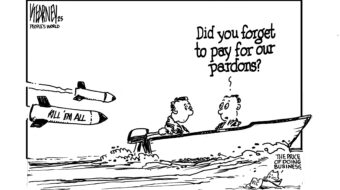
WASHINGTON—The 35-day federal government shutdown/lockout left the U.S. aviation system near collapse, the president of the National Air Traffic Controllers Association (NATCA) says.
And it could happen again as soon as mid-February, warns union President Paul Rinaldi.
Rinaldi reviewed the shutdown and its impact in a Jan. 29 speech to the Aero Club of Washington – a group of private pilots, interests concerned with aviation (including unions) and others – and a follow-up question and answer session with reporters.
“Can this happen again?” he asked rhetorically in his speech. “Yes.” The air traffic impact alone affected 12 million people directly, millions more indirectly, and impacted 1/20th of the U.S. economy – the same share directly attributable to auto industry employment.
“It’s the proverbial Humpty-Dumpty,” Rinaldi told reporters afterwards about the shutdown. “Put it back together, but it could fall down again.“ Of this shutdown/lockout, he later added: “It’s terrorism.”
Air traffic controllers played a key role in ending the shutdown/lockout. GOP President Donald Trump gleefully imposed it at midnight on Dec. 21 in the Transportation Department – including the controllers and the Federal Aviation Administration – eight other Cabinet departments and many other agencies.
Trump ordered 350,000 workers to stay on the job, without pay, including the 14,000 controllers, and locked out 450,000 more. His price for reopening the government was congressional kowtowing to his demand for $5.7 billion for his Mexican Wall, which foes call racist, immoral or both. Rinaldi noted it was the third shutdown in the last 18 months.
Trump finally caved in after an hour-and-22-minute morning shutdown of New York’s busy LaGuardia Airport due to lack of staffing. That shutdown rippled throughout the U.S. air system.
Rinaldi said the real blockage came at an en route air traffic control tower in Leesburg, Va., dozens of miles outside of D.C., which controls a huge chunk of airspace over several states. It’s one of 20 such big air traffic en route towers, called Tracons, in the U.S.
Six of the 13 A.M. shift controllers were unable to report for work at Leesburg, calling in sick, he said. That forced grounding of planes and flight delays over many states. The Leesburg tower was fully staffed for the P.M. shift. The controllers did not strike – federal law bars them and other federal workers from doing so – and NATCA had no role in their call-in.
Because of the stressful nature of their jobs, monitoring dozens of planes each for 10-hour shifts, to make sure they take off, fly and land safely, controllers must meet high health standards to report to work daily, Rinaldi later explained. They can’t take anything stronger than an Advil without medical clearance, and they can’t come to work fatigued in any way.
With unpaid controllers “driving Ubers and Lyfts” and taking other second jobs before and after working hours, to put food on the table for their families, many were unfit for duty, Rinaldi said.
Those that came to work were distracted by worries, Rinaldi told reporters afterwards. He described the story of a 17-year controller wondering, after he let two planes on the ground get too close to each other, “How did I do that?” His colleagues caught the mistake. The controller was worried about feeding his family.
“How many people here would go to work for five straight weeks not knowing when – or if – they’re going to get paid?” Rinaldi asked the crowd. “They did their jobs every day, and the U.S. Congress and the president did not do their jobs.”
By the time Trump caved in, his shutdown/lockout left 800,000 federal workers without pay for a month, millions of federal contract workers – including instructors at the Federal Aviation Administration’s air traffic control school in Oklahoma City – with no pay and no prospects of ever getting it back, and a net $3 billion cost, at least to the U.S. economy.
It also left the workers, federal and contract, scrambling to pay mortgages or the rent, having to skip medical appointments or prescriptions, visit food banks to feed their families and often facing medical bills after having their health care coverage cut off.
Trump’s lockout/shutdown also left millions of other people nationwide who depend on federal funds in some way, scrambling. For example, one Native American tribe in the Kansas-Oklahoma area had to lay off most of its 22 workers, including all of its police officers, because federal funding for them, through the Interior Department, wasn’t there.
And a woman who toils as a contract cleaner in the Homeland Security Department had her health insurance cut off when DHS shut down. The insurance pays for her husband’s treatment for advanced multiple sclerosis.
Transportation Security Officers – the airport screeners – faced enormous lines and some smaller airports had to cut back as screeners, who were also unpaid, were shifted to larger ones to handle the crowds. They’re going to get only one week’s pay, so far, at the end of this week. The NATCA members will get their five weeks’ worth of back pay in three separate chunks.
There will be permanent impacts, too, Rinaldi warned. Morale is low among the controllers because they “lost time, lost energy and lost heart.” Key modernization programs, including runway repairs, upgrading the air traffic system and training new controllers, have fallen behind. The 400 controller trainees at Oklahoma City may not return.
That would only worsen the current 3,000-controller shortage. And Rinaldi told reporters that 20 percent of the current 14,000 controllers are eligible to retire immediately.
At least one plans to do so. The controller, a personal friend, reported for work at Boston’s Logan Airport the day the government reopened, took one look at the chaos and called him.
“He told me ‘I planned to retire in three years’” when the FAA mandates controllers retire, due to the accumulated stress of their jobs, at age 56. “’Forget it,’ he said. ‘I’m leaving now.’”










